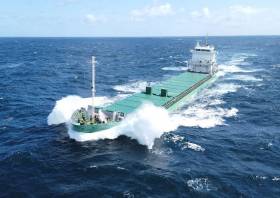Displaying items by tag: Arklow Day
Five Injured Crew Airlifted From Irish Cargo Ship In Bay Of Biscay
Five crew were evacuated from an Irish cargo vessel yesterday (Tuesday 10 December) after encountering rough seas in the Bay of Biscay, as Maritime Bulletin reports.
The Arklow Day has previously left Aviles Port in northwest Spain on Monday evening (9 December) after offloading its cargo but sailed into challenging conditions, with waves reportedly nine metres high.
One of these waves struck five of the vessel’s 10 crew, believed to have been on deck in the open at the time, who were left with ‘serious’ injuries.
The wounded seamen were airlifted to hospital by a Spanish rescue helicopter while the remaining five crew took the ship to the nearest port at El Musel on the Cantabrian coast.
The Arklow Day was acquired by Arklow Shipping from the Flinter Group two years ago, as previously reported on Afloat.ie. The 132m vessel, previously known as Flinter Aland, has a 13,008m3 hold capacity and a speed of 12 knots.
























































